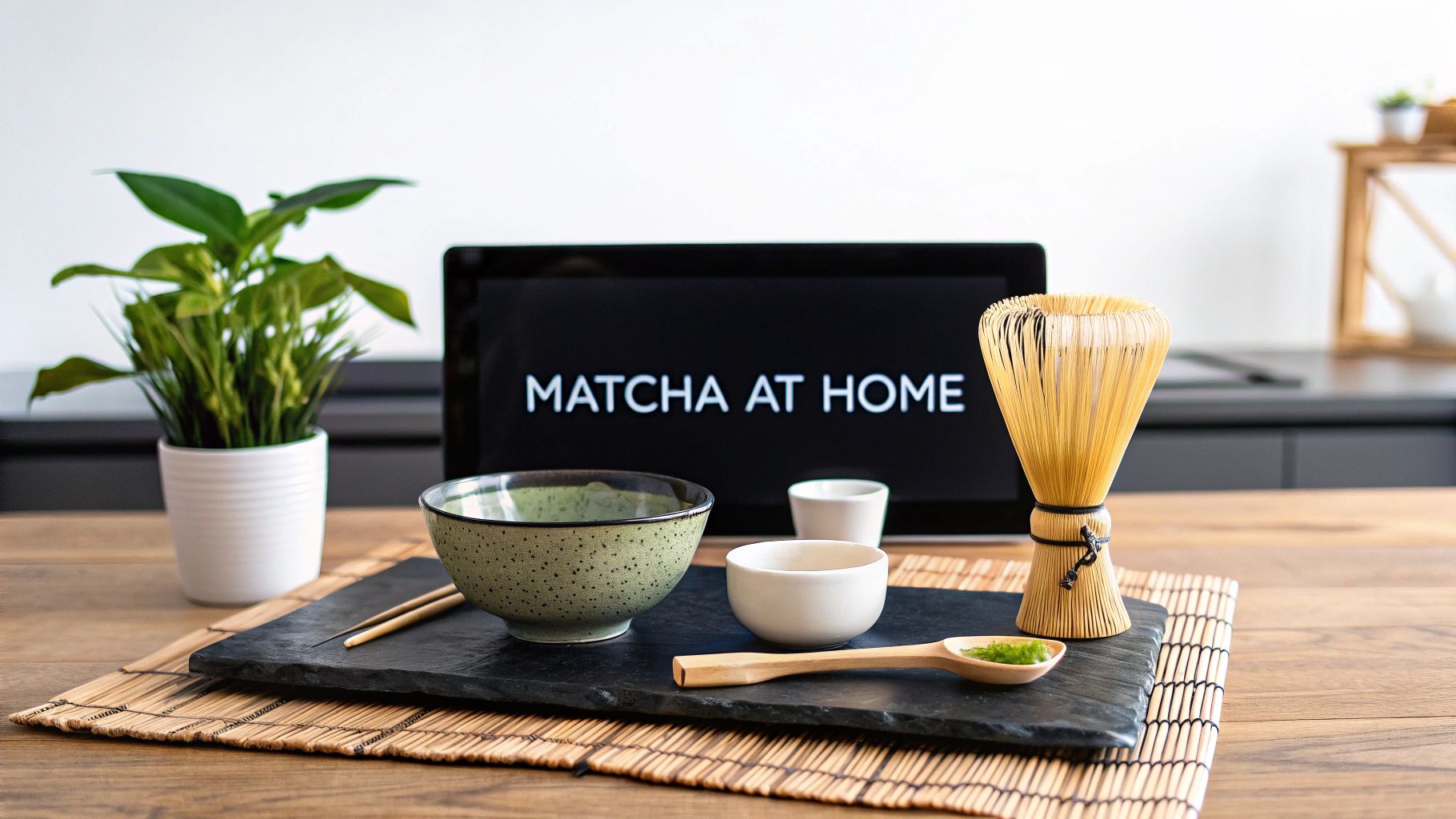A tea ceremony matcha is so much more than just a drink. It's a mindful, deliberate practice known as 'Chanoyu' or "the way of tea." This beautiful ritual transforms finely ground green tea into a moment of focus, tranquillity, and appreciation—an art form you can absolutely embrace in your own home.
Embracing The Ritual Of Tea Ceremony Matcha
In a world that never seems to stop, the idea of pausing for a structured ritual can feel like a breath of fresh air. The Japanese tea ceremony offers exactly that: a quiet space to reconnect with the present moment. While it’s a practice deeply rooted in centuries of tradition, its core principles feel more relevant than ever for our modern lives.
This isn’t about just quickly whisking some powder and water together. It’s an intentional process, built on four key pillars that elevate a simple beverage into a truly meaningful experience.
The Four Pillars of Chanoyu
At its heart, the ceremony is guided by a philosophy that shapes every single movement and thought. Getting to grips with these concepts is the first step toward appreciating the real depth of the ritual. The principles are Wa (和), Kei (敬), Sei (清), and Jaku (寂).
Let's break down what these mean in the context of the ceremony.
The Four Principles of the Japanese Tea Ceremony
| Principle (Japanese) | Principle (English) | Meaning in the Ceremony |
|---|---|---|
| Wa (和) | Harmony | This reflects the peaceful connection between the host, guests, nature, and the utensils. It’s about creating a balanced, serene environment. |
| Kei (敬) | Respect | This principle encourages humility and genuine respect for others, the tea, and the objects used. It’s shown through gestures like bowing and careful handling of the tea bowl. |
| Sei (清) | Purity | This refers to both physical and spiritual cleanliness. Cleaning the tools before the ceremony symbolises purifying the heart and mind, letting go of worldly distractions. |
| Jaku (寂) | Tranquillity | This is the ultimate goal—a state of calm and inner peace achieved through the practice. It’s a quietude you can carry with you long after the last sip. |
These principles work together to create an atmosphere of mindfulness. As you learn more about the traditional Japanese tea ceremony, you'll start to see how every element, from the choice of bowl to the way it’s held, reinforces these beautiful ideals.
A Modern Resurgence in Britain
The appeal of this mindful practice is definitely growing. Matcha, the star of the show, has seen a remarkable surge in popularity right here in the UK. In 2023 alone, sales of matcha drinks shot up by an incredible 202%.
This is more than just a trend; it’s a testament to a wider appreciation for Japanese culture and wellness rituals. It shows a real shift towards more intentional consumption, where the experience is just as important as the product itself.
The Japanese tea ceremony embodies the ideals of tranquillity, respect, purity, and reverence; guests who are fortunate enough to take part in the ceremony will come away from the experience feeling refreshed and at peace.
This guide is here to demystify the process, making the rich tradition of tea ceremony matcha accessible for everyone. Consider this your first step toward mastering this beautiful art form in your own home.
Assembling Your Essential Matcha Tools
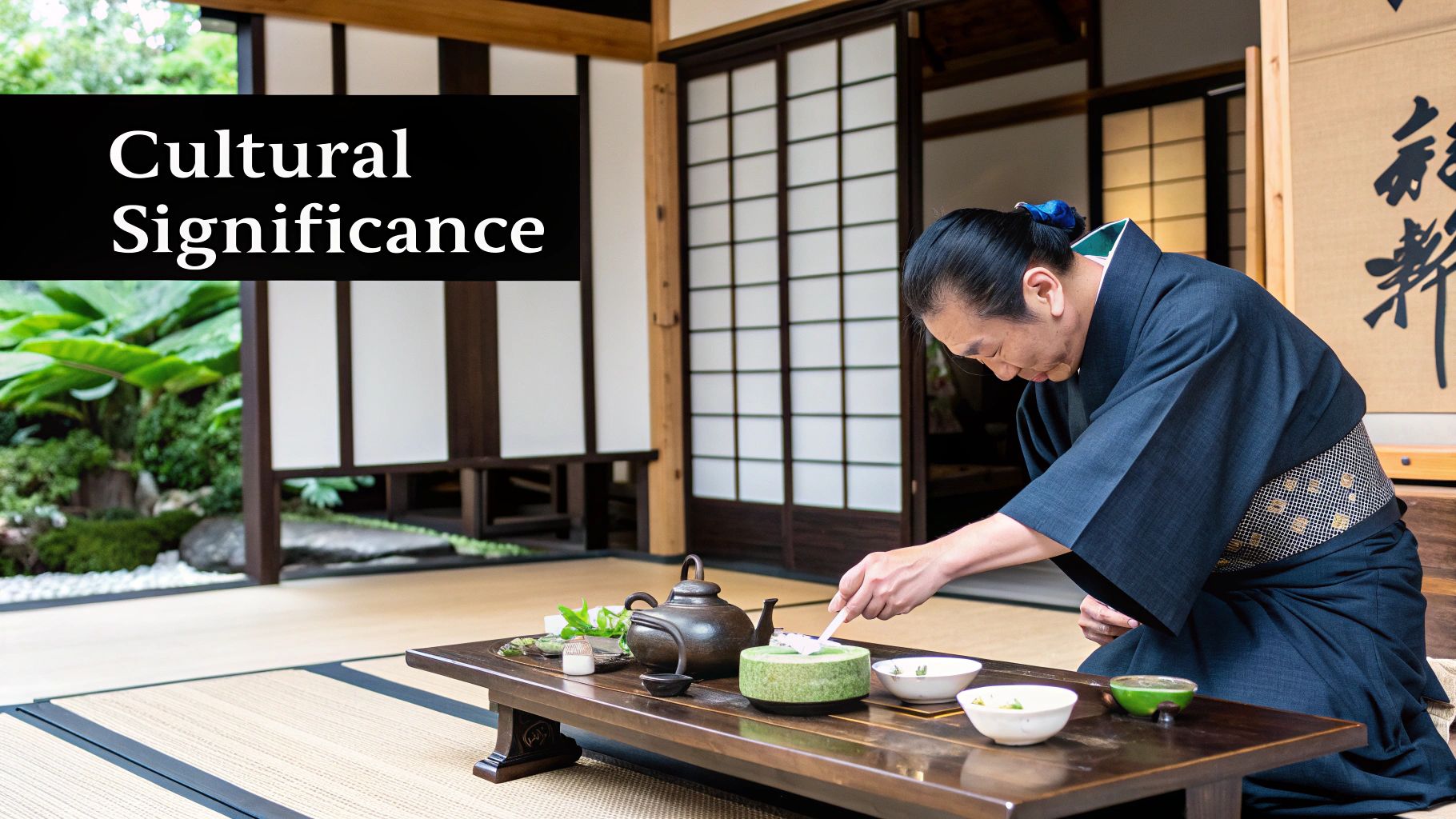
To really get into the practice of a tea ceremony matcha, you'll need a few specialised utensils. The Japanese call them ‘dogu’. While you might see elaborate, ornate collections, don't be intimidated. Getting started is much simpler than it looks. The real focus should always be on quality and how the tools function, not just collecting a huge set.
Think of these tools as your partners in the ritual. Each one has a specific, time-honoured role, perfected over centuries to help you create that perfect bowl of matcha. Let's walk through the absolute essentials. I'll explain what they do and what to look for, so you can put together your first kit with confidence.
The Heart of the Ceremony: The Chawan
The 'Chawan' (tea bowl) isn’t just a cup. It's the very vessel where your matcha comes to life. A proper chawan is wide and deep enough to let you whisk vigorously without making a mess. This generous space is absolutely crucial for creating that rich, creamy foam which is the hallmark of expertly prepared matcha.
When you’re choosing a bowl, here’s what matters most:
- Shape: Look for one with a fairly flat bottom and sides that aren't too curved. This design makes a world of difference when whisking, ensuring you catch all the powder.
- Material: Traditionally, you’ll find chawan made from earthenware or porcelain. Whatever you choose, it needs to be sturdy enough to handle the hot water used for warming the bowl before you even start.
- Aesthetics: This is more important than you might think. Choose a bowl that feels right in your hands and gives you a sense of calm. The visual appeal is a huge part of the ritual's beauty.
Of course, you can start with a wide soup bowl from your kitchen, but investing in a dedicated chawan truly elevates the experience. It helps signal that this time is special, set apart from your daily routine.
The Indispensable Whisk: The Chasen
If there’s one tool you absolutely cannot skip, it’s the 'Chasen' (bamboo whisk). This intricate tool is a small work of art, typically hand-carved from a single piece of bamboo. Its fine tines are expertly crafted to froth the matcha into a smooth, velvety liquid. Honestly, a metal whisk or an electric frother just can't replicate the delicate foam a chasen produces.
The quality of a chasen is often judged by its number of prongs, or tines. A whisk with 80 to 120 tines is the sweet spot for beginners and seasoned enthusiasts alike. It strikes the perfect balance for creating a superb foam. A quick tip: always soak your chasen in warm water for a few minutes before each use. This softens the bamboo and prevents the delicate tines from becoming brittle and snapping.
A high-quality bowl and an effective whisk are the non-negotiables for an authentic experience. They are the core components that directly impact the final taste and texture of your matcha. The right tools transform preparation from a task into a meditation.
The Supporting Cast: Chashaku and Natsume
While the chawan and chasen are the stars of the show, a couple of other tools play vital supporting roles.
The 'Chashaku' is the traditional bamboo scoop used to measure the matcha powder. Its elegant, curved shape is designed to gracefully transfer just the right amount of tea from its caddy to your bowl. For a single serving, one or two scoops are usually all you need.
Finally, there's the 'Natsume', the tea caddy. This is a small, lidded container that holds the matcha powder. Its main job is to keep the delicate tea fresh and protected from light and humidity, which can quickly degrade its vibrant colour and complex flavour. While any small airtight container will do in a pinch, a traditional natsume adds a lovely touch of authenticity to your setup.
Starting your journey into the world of tea ceremony matcha is about choosing a few key, quality items. By focusing on a great bowl and an exceptional whisk, you lay the foundation for a truly rewarding and mindful practice.
Selecting a True Ceremonial Grade Matcha
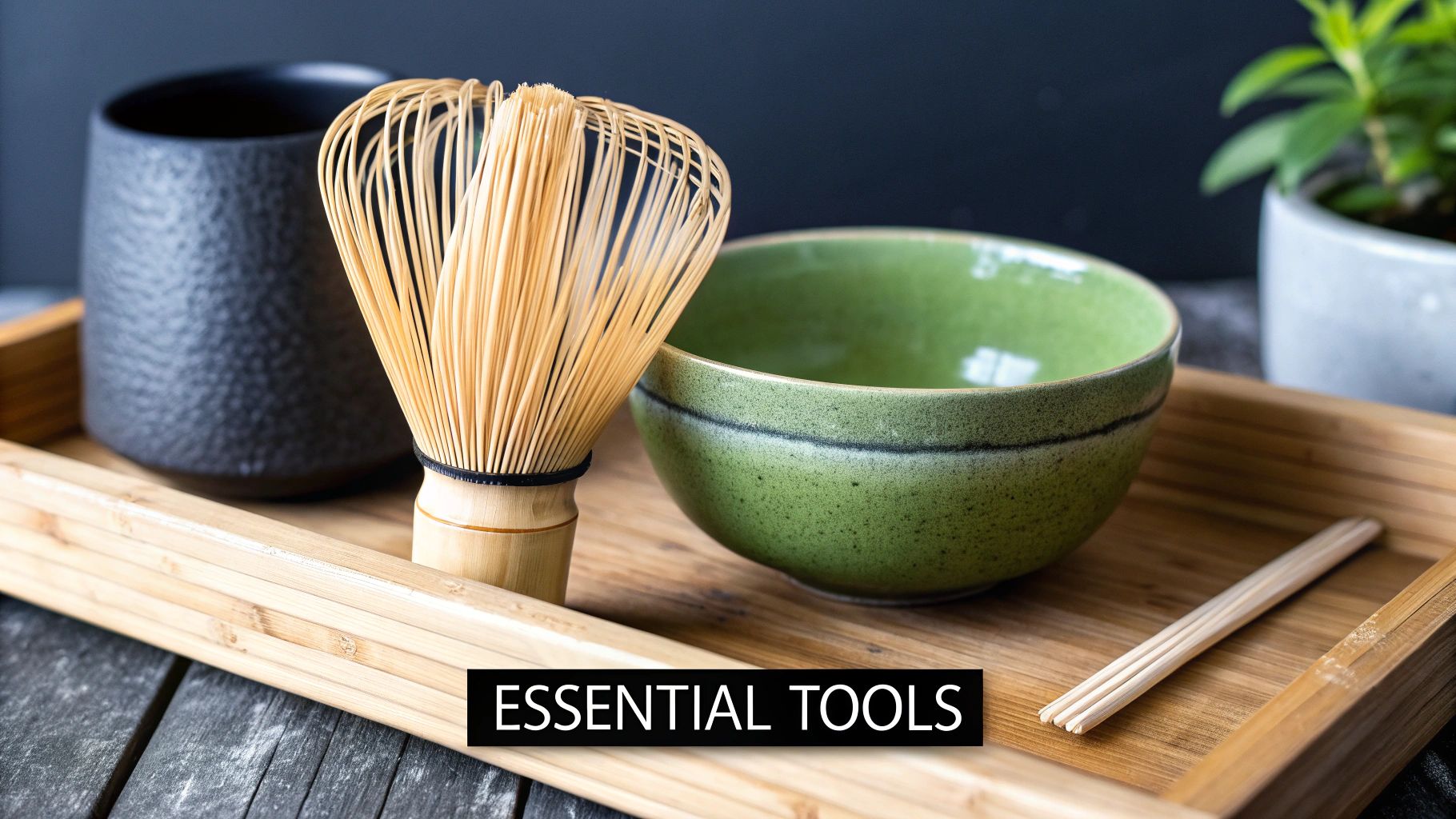
With your essential tools ready, we come to the very heart of the practice: the tea itself. The quality of your tea ceremony matcha is the single most important element. Using a genuine ceremonial grade powder doesn’t just make the tea taste better; it defines the entire experience.
You'll quickly discover that not all green powders are created equal. The market is flooded with products labelled "matcha," but many of these are actually culinary grade, which is something else entirely. Culinary matcha is designed for mixing into lattes, cakes, and smoothies. Because it’s made from older, more mature tea leaves, it has a more bitter, astringent taste and a duller, yellowish-green hue.
For an authentic ceremony, you simply must have true ceremonial grade matcha. This distinction is what allows you to achieve the correct taste, texture, and mindful state the ritual is designed to cultivate.
What Defines Ceremonial Grade Quality
Learning to identify a top-tier ceremonial matcha is a skill that involves all your senses. It's a bit like becoming a connoisseur of fine wine; you learn to spot the subtle cues that separate the exceptional from the ordinary.
The origin, harvest time, and processing method all play a massive part in the final product. Here’s what you should be looking for:
-
Vibrant Colour: True ceremonial matcha boasts a brilliant, almost electric green colour. This isn’t just for show; the vibrant hue comes from being shade-grown and made from the youngest, most tender tea leaves, which are packed with chlorophyll. A dull, olive, or brownish tone is a dead giveaway of a lower-grade or old product.
-
Fine, Silky Texture: Rub a little between your fingers. The powder should feel incredibly fine and silky, almost like talcum powder or cornflour. This ultra-fine consistency is achieved through a painstaking stone-milling process. If it feels gritty or coarse, it wasn't ground properly and will never dissolve smoothly in water.
-
Rich, Sweet Aroma: Open the tin and take a good sniff. High-quality matcha has a complex aroma that is both fresh and slightly sweet, with notes of young grass and a deep, savoury undertone. If it smells dusty, flat, or has an unpleasant "fishy" quality, it's a sign of poor quality.
This sensory checklist is your best friend when navigating your options. It's the most reliable way to ensure you select a powder that is truly worthy of your ritual.
The use of matcha in a ceremonial context is a tradition stretching back to the 12th century, when Zen Buddhist monks used it to aid meditation. The practice was later refined into the formal 'chanoyu' tea ceremony, and while it remains a cherished art in Japan, its appeal has grown worldwide. In the UK, interest began to stir among tea enthusiasts as early as 2004, aligning with a growing desire for authentic, premium wellness experiences. Discover more about the historical journey of ceremonial grade matcha and its modern revival.
The Importance of Origin and Harvest
Beyond how the matcha looks, feels, and smells, its story is just as critical. The most prestigious and sought-after matcha comes from Uji, Japan, a region near Kyoto celebrated for its ideal tea-growing climate and centuries-old cultivation techniques. Matcha from Uji is, for many, the gold standard.
Equally important is the harvest. Ceremonial grade matcha is exclusively made from the first harvest leaves, known as Ichibancha. These are the very first, most tender leaves of spring, which are bursting with nutrients and a deep, savoury flavour known as umami. This rich, brothy taste is the signature of superior matcha and is what makes the experience so deeply satisfying.
For your ceremony, we recommend Amatsu's ‘Pure’ Ceremonial Grade Matcha. Sourced directly from the esteemed fields of Uji and crafted from first-harvest leaves, it embodies all these vital characteristics. Its brilliant green hue, silky powder, and profound umami flavour provide the perfect foundation for an authentic and deeply rewarding tea ceremony. Using a matcha like ‘Pure’ is your best bet for achieving that perfect, stable froth and an unforgettable flavour that elevates your ritual into something truly sublime.
How to Prepare Your Perfect Bowl of Matcha
Now we come to the best part of the ritual—the hands-on creation of your tea ceremony matcha. This is where your intention meets action, transforming that fine green powder and warm water into something truly special. The process itself is a form of meditation, a series of deliberate movements designed to coax out the perfect texture and flavour.
I’ll walk you through this beautiful practice, from warming your tools to that final, satisfying whisk. Try to see these as fluid movements, not just rigid steps. Each action flows into the next, building towards a moment of pure, mindful enjoyment. This is the heart of the ceremony, a skill you'll refine and treasure with every single bowl you make.
Awakening the Bowl and Sifting the Tea
Before a single grain of matcha enters the bowl, the real preparation begins with warmth. Pour a little hot water—from the same kettle you'll use for the tea—into your chawan. Gently swirl it around. This isn't just for show; it serves two key purposes. First, it pre-warms the bowl so your matcha doesn’t cool down too quickly. Second, it's the perfect chance to soften the tines of your chasen (whisk) by standing it in the warm water for a moment.
Once you’ve done that, discard the water and dry the bowl completely with a clean cloth.
With your bowl now warm and ready, we move to what is arguably the most critical step for a silky-smooth brew: sifting. Matcha powder is so incredibly fine that it naturally loves to clump together. Sifting it through a fine-mesh sieve isn't just a suggestion; it’s non-negotiable if you want a perfect bowl.
This single act breaks up any tiny clumps, ensuring your finished tea is utterly smooth, with none of that gritty texture. It also aerates the powder, which helps you create a much richer and more stable foam later. Just place your sieve over the chawan and gently push the matcha through with your chashaku or the back of a small spoon.
Measuring and Whisking to Perfection
Time for the matcha itself. Using your bamboo scoop, the chashaku, measure the sifted powder into your warmed bowl. A traditional serving is usually one to two scoops, which comes out to about 1-2 grams (or roughly half a teaspoon). For a truly authentic experience with Amatsu’s ‘Pure’ Ceremonial Grade Matcha, we find that two scoops create a wonderfully rich and balanced flavour.
Next, add the water. The temperature here is absolutely crucial. Water that's too hot, especially if it's boiling, will scorch the delicate tea leaves. The result? A bitter, unpleasant taste and no hope of forming a good foam. You're aiming for a temperature between 70-80°C. If you don't have a temperature-controlled kettle, an easy trick is to boil the water and then let it sit and cool for a few minutes.
Pour about 60-70ml of the warm water over the powder.
The image below shows this simple yet vital flow for preparing your matcha.
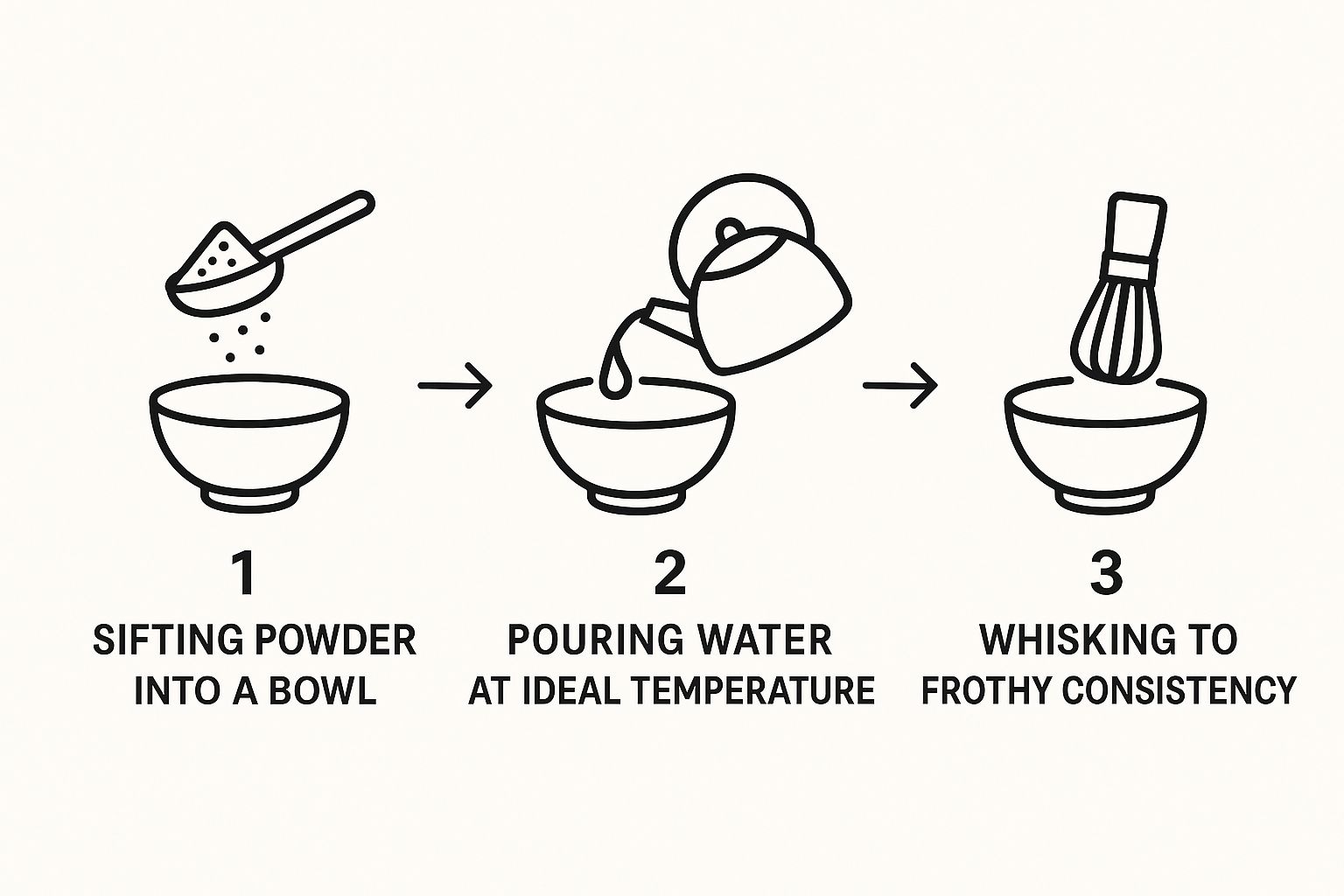
As you can see, these three foundational actions—sifting, adding correctly tempered water, and whisking—are the pillars of a great bowl of matcha.
Now, for the magic. Hold the chawan steady with one hand and take your chasen in the other. Submerge the tines and begin whisking in a rapid "W" or "M" motion. The secret is to move quickly from the wrist, not your whole arm, keeping the whisk just off the bottom of the bowl. Your goal is to vigorously agitate the mixture, dissolving the powder completely while whipping air into it to create a thick, creamy layer of foam.
The perfect froth, known in Japanese as kama, should be a sea of tiny, uniform bubbles, with a creamy texture and a vibrant jade colour. This is the hallmark of a well-prepared bowl and a sign of success in your preparation.
When you've achieved that lovely froth, slow your whisking right down. Gently move the chasen in a circle around the surface to pop any large bubbles. To finish, draw the whisk straight up from the centre of the bowl; this will create a slight mound in the foam, a beautiful final touch.
Troubleshooting Common Problems
Even with the best intentions, things can sometimes go awry. Don't worry, it happens to everyone. Getting the hang of it is part of the journey. Here's a quick guide to some common issues and how to fix them.
| Common Problem | Likely Cause | Simple Solution |
|---|---|---|
| Gritty or clumpy tea | The matcha wasn't sifted properly before adding water. | Always sift your matcha powder through a fine-mesh sieve. This is the most common and easiest mistake to fix. |
| Bitter taste | The water was too hot, scorching the delicate tea leaves. | Let boiled water cool for a few minutes to reach the ideal 70-80°C range. A temperature-controlled kettle is a great investment. |
| No foam or very thin foam | The whisking technique needs adjustment, or the water-to-matcha ratio is off. | Focus on a rapid "W" or "M" motion from the wrist. Ensure you're using enough matcha for the amount of water (1-2g for 60-70ml). |
| Large, soapy bubbles | The whisking motion was too slow or not vigorous enough. | Increase the speed of your wrist movement. A final, slow swirl on the surface can help smooth out the foam. |
Perfecting your technique takes a bit of practice, but these simple adjustments can make a world of difference. Soon enough, making a beautiful bowl of matcha will feel like second nature.
Integrating Modern Wellness into an Ancient Ritual
This sacred method of preparation isn't just for traditional matcha. You can apply the same mindful process to Amatsu’s functional blends, weaving modern wellness goals into a timeless ritual.
Here are a few ideas:
- For a pre-workout boost: Prepare a bowl of Amatsu ‘Strength’ with creatine using the exact same ceremonial method.
- For a beauty-from-within moment: Whisk up Amatsu ‘Radiance’ with marine collagen for a nourishing, skin-loving treat.
- For enhanced mental clarity: A ceremonially prepared bowl of Amatsu ‘Shrooms’ with adaptogenic mushrooms can centre your mind before a demanding task.
By applying this time-honoured technique to these specialised blends, you honour the spirit of the ceremony while tailoring the benefits to your daily needs. This fusion ensures that every bowl, whether purely traditional or functionally modern, becomes a true act of intention and care.
The Art of Serving and Savouring Your Matcha
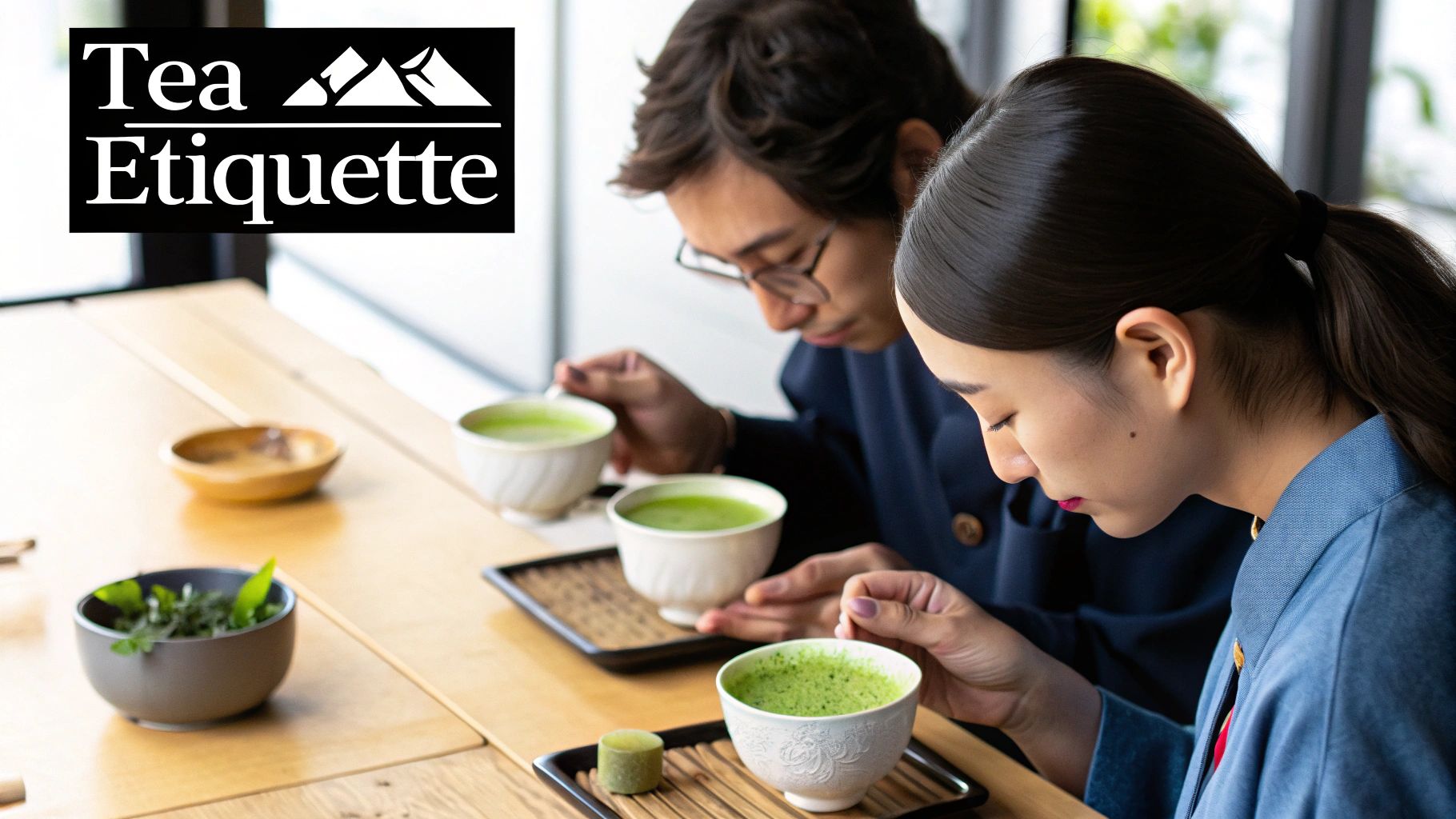
The journey of a tea ceremony matcha doesn't end once the whisking stops. In many ways, this is where the real experience begins. The mindful act of drinking the tea is the culmination of the ritual, transforming a simple beverage into a powerful, meditative practice that engages all your senses.
Once you’ve whisked your perfect bowl, the way you hold it is steeped in tradition. You should cradle the chawan (tea bowl) with both hands—your left palm supporting the base and your right hand gently steadying the side. This isn’t just about preventing spills; it’s a gesture of respect and appreciation for the tea and the moment.
Presenting and Receiving the Bowl
In a formal ceremony, the host presents the bowl with its most beautiful or decorative side—its "front"—facing the guest. As a sign of humility, the guest receives it and rotates it slightly clockwise in their palms. This small, deliberate turn is to avoid drinking directly from the bowl's "front," showing respect for the vessel and the host’s thoughtful preparation.
Before your first sip, just pause. Take a second to admire the vibrant, jade-green colour and the delicate foam you worked so hard to create. Bring the bowl closer and inhale the fresh, grassy aroma. This moment of stillness is a crucial part of the experience, grounding you in the sensory beauty of what you’ve made.
Transforming Sips into Meditation
This mindful approach to drinking is a chance to find a pocket of calm in your day. Many people find the sustained, focused energy from matcha a welcome change from the jittery spike of other caffeinated drinks. If you're weighing your options, you can explore more about how matcha's clean energy compares to coffee in our guide. This calm alertness is exactly what the ceremony is designed to nurture.
With each sip, focus entirely on the flavour profile—the deep, savoury umami, the hint of sweetness, and the smooth, creamy mouthfeel. Even if it's just for five minutes, try to create a quiet, dedicated space for this. Simply turning off notifications can profoundly deepen your connection to the ritual, turning it into a genuine sanctuary.
The Japanese tea ceremony is built around aesthetic appreciation. The decor, such as flower arrangements, is often tailored to the season, and the tea bowl is chosen to reflect the time of year. Guests are encouraged to notice these details, a practice you can easily adopt at home to make the occasion feel more special.
The Perfect Pairing: Wagashi
To balance the rich, slightly astringent notes of the matcha, a small sweet known as wagashi is traditionally served. This is far more than just a little treat; it’s a key part of the flavour journey. The sweetness of the wagashi cleanses the palate, preparing you to fully appreciate the matcha’s complex character.
You don’t need to source elaborate, traditional wagashi to enjoy this beautiful pairing. It’s the principle that counts. Here are a few simple ideas that work just as well:
- Mochi: These soft, chewy rice cakes are easy to find and come with various fillings.
- A piece of high-quality dark chocolate: Its rich bitterness is a fantastic complement to matcha's unique flavour.
- A single dried fruit: A simple date or a piece of candied ginger provides a lovely, natural sweetness.
- A plain biscuit or shortbread: Something simple and not overly sweet provides the perfect counterpoint.
By mindfully serving, holding, and savouring your matcha, you bring the ceremony full circle. You honour the tea, the tools, and most importantly, the quiet moment of peace you’ve carved out for yourself.
Your Questions About Matcha Ceremony Answered
As you step into the world of the tea ceremony matcha, it’s completely natural for questions to surface. It’s a beautiful ritual, and while it's accessible to everyone, its nuances can feel a little puzzling at first.
We’ve gathered some of the most common queries and provided clear, straightforward answers. Think of this as your friendly guide to navigating both the practical steps and the cultural spirit with confidence.
What Is The Difference Between Ceremonial and Culinary Matcha?
This is probably the most crucial question, and getting it right makes all the difference.
Ceremonial grade matcha, like our Amatsu ‘Pure’, is crafted from the very youngest, most delicate leaves of the first harvest. These special leaves are shade-grown and then meticulously stone-ground into an incredibly fine, vibrant green powder. Its entire purpose is to be whisked with water and savoured on its own, delivering a smooth, complex umami flavour without a hint of bitterness.
Culinary grade, on the other hand, comes from older leaves picked in later harvests. This gives it a more astringent, slightly bitter taste and a duller, more yellowish hue. It’s perfectly good for lattes, smoothies, or baking—where other ingredients can balance its stronger flavour—but it’s just not right for a traditional tea ceremony. For that authentic experience, ceremonial grade is non-negotiable.
Why Is My Matcha Clumpy Instead of Frothy?
Clumps are the enemy of a perfect bowl of matcha, and a rich froth is the ultimate prize. If you're finding your matcha is clumpy, the answer almost always lies in two places: sifting and water temperature.
Matcha powder is so fine that it naturally wants to stick together. The single most important thing you can do for a smooth, velvety texture is to sift the powder through a fine-mesh sieve before you add any water. Don't skip this step!
The other common culprit is water that’s too hot. Boiling water (100°C) will scorch the delicate tea, making it taste bitter and killing the very compounds that help create a stable foam.
For that ideal froth, aim for water heated to around 70-80°C. This temperature coaxes out the best flavours without any bitterness. A proper bamboo whisk (chasen) and a quick "W" or "M" motion are also key to aerating the tea properly.
Can I Perform a Tea Ceremony Without All the Traditional Tools?
Absolutely. While having a full set of dogu (utensils) certainly adds to the ritual, you can definitely start with just the essentials. The spirit of the ceremony—mindfulness, respect, and appreciation—is far more important than owning every single piece of kit from day one.
If you're just starting out, there are only two things you truly can't do without:
- High-Quality Ceremonial Grade Matcha: The taste and texture of the tea are everything.
- A Bamboo Whisk (Chasen): A metal whisk or an electric frother just can't replicate the unique, delicate foam that a chasen is designed to create.
For the bowl, any wide, ceramic bowl from your kitchen will work perfectly well to begin with. As your practice grows, you can gradually build your collection. The ceremony is a personal journey, so let your setup evolve with you.
How Do I Fit The Matcha Ritual Into My Daily Routine?
Weaving a mindful ritual into a packed schedule is a powerful wellness practice in its own right. The key is to see it not as another chore, but as a deliberate, restorative pause.
A fantastic place to start is by swapping your morning coffee for a ceremonially prepared bowl of matcha. It's a switch more and more people are making, and you can read more about why Londoners are ditching coffee for matcha in our dedicated post.
The real goal is to keep the intentional, focused preparation. This is what turns a simple daily habit into a moment of calm and clarity.
You can also adapt the ritual to fit modern wellness goals:
- A Pre-Workout Energiser: Use the ceremonial method with Amatsu 'Strength' for a focused energy lift.
- A Skin-Nourishing Moment: Prepare a bowl of Amatsu 'Radiance' with collagen to support your beauty regimen.
- A Mind-Centring Break: Whisk up Amatsu 'Shrooms' with adaptogens before starting a big project.
By preserving the method, you honour the tradition while tailoring the benefits to your life. This makes every cup a purposeful and restorative experience.
Ready to begin your own mindful ritual? The journey starts with the right foundation. Amatsu Matcha offers authentic, Uji-sourced ceremonial grade matcha and functional blends designed to elevate your daily wellness.
Explore our collection and find the perfect matcha for your practice today.
Read more
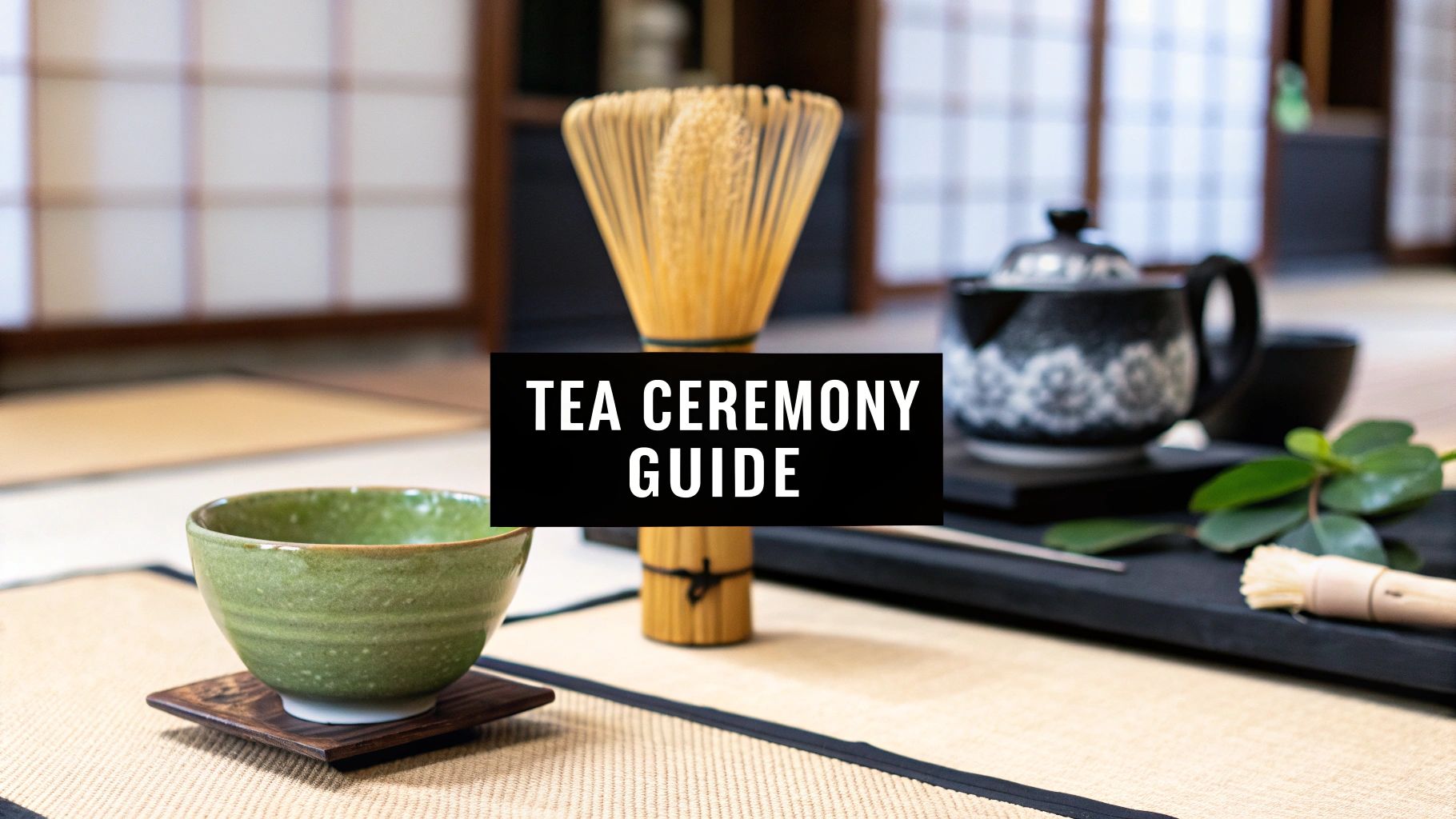
Discover the art of the traditional Japanese tea ceremony. This guide explains its philosophy, steps, and how to practice its mindful principles today.
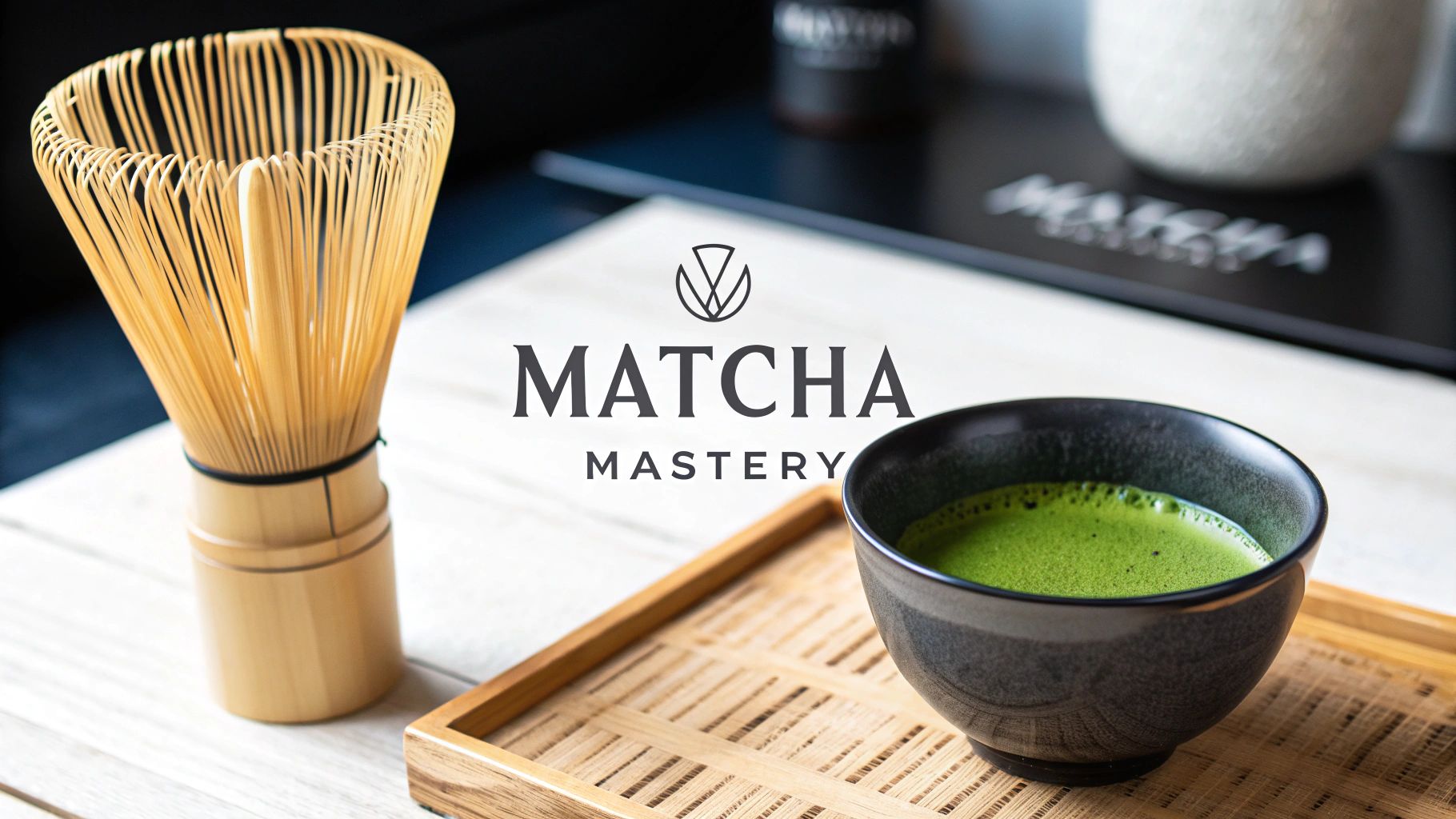
Discover the world of Japanese tea matcha. This guide covers its health benefits, brewing rituals, and how to choose the right grade for you.
